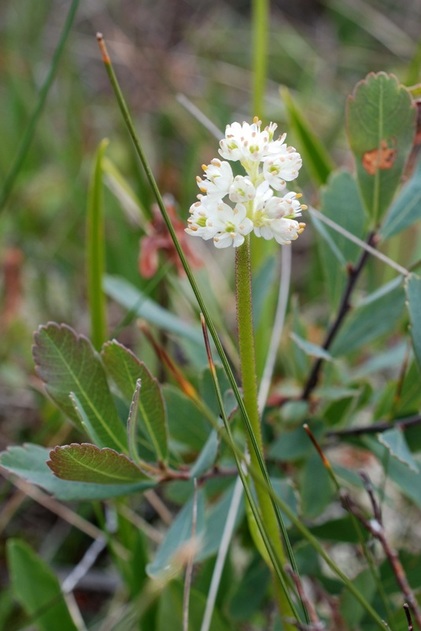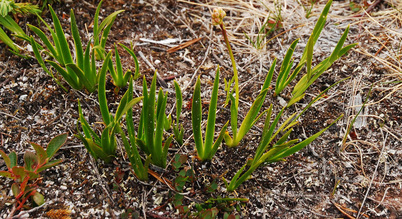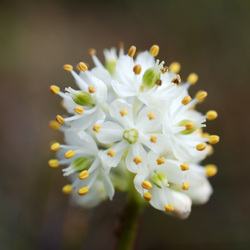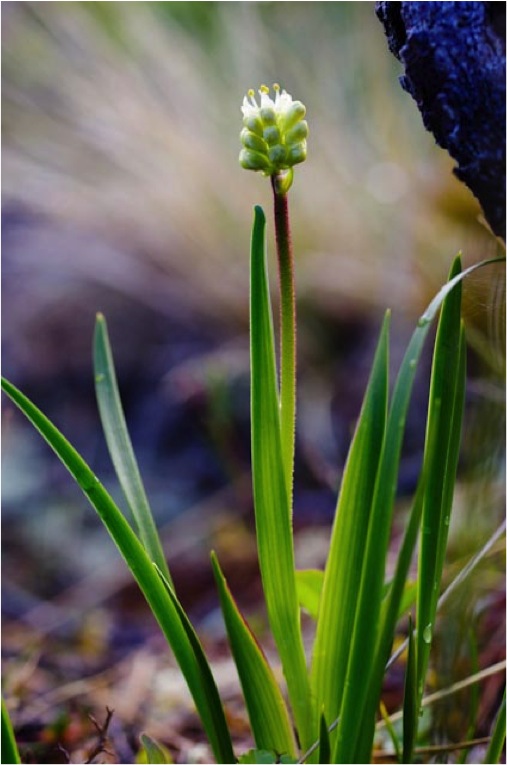Sticky false asphodel, sticky tofieldia • Triantha glutinosa, Tofieldia glutinosa
{Asphodel = flower of the Elysian Fields, or the fields inhabited by souls of the deceased, in Homer; Tofieldia = for Thomas Tofield, an English botanist in the 1700's}
Identification
Sticky false asphodel is a perennial flower that tends to grow in small clumps. Its stem, arising from a short vertical rhizomes, grows to 40 cm tall. The upper part of the stem is sticky and hairy. A few long, narrow, folded basal leaves, about half the height of the stem, sheath the base of the stem. There may be one or two smaller leaves attached to the lower stem. The flowers are small and clustered together at the top of the stem. They are whitish to greenish white. The fruits are reddish-purple capsules.
Habitat & Range
This species is found from low to alpine elevations. It grows in open, wet areas, such as moist meadows, streamsides, and around bogs and fens. It can be locally abundant. It is found throughout a large portion of North America: its range stretches along the coast from Alaska to Oregon, and east through most of Canada and the eastern United States (click here to see a range map).
Similar Species
Common false asphodel (Tofieldia pusilla), an uncommon species found in certain regions of BC, is similar but is smaller (5-20 cm tall), does not have the sticky upper stem of the sticky false asphodel, and its basal leaves are many and grouped together in fan-like tufts.
Sticky false asphodel is a perennial flower that tends to grow in small clumps. Its stem, arising from a short vertical rhizomes, grows to 40 cm tall. The upper part of the stem is sticky and hairy. A few long, narrow, folded basal leaves, about half the height of the stem, sheath the base of the stem. There may be one or two smaller leaves attached to the lower stem. The flowers are small and clustered together at the top of the stem. They are whitish to greenish white. The fruits are reddish-purple capsules.
Habitat & Range
This species is found from low to alpine elevations. It grows in open, wet areas, such as moist meadows, streamsides, and around bogs and fens. It can be locally abundant. It is found throughout a large portion of North America: its range stretches along the coast from Alaska to Oregon, and east through most of Canada and the eastern United States (click here to see a range map).
Similar Species
Common false asphodel (Tofieldia pusilla), an uncommon species found in certain regions of BC, is similar but is smaller (5-20 cm tall), does not have the sticky upper stem of the sticky false asphodel, and its basal leaves are many and grouped together in fan-like tufts.
References
Pojar, J. and MacKinnon, A. (1994). Plants of Coastal British Columbia, Revised. Vancouver, BC: Lone Pine Publishing. P. 103.
Tofieldia pusilla (Michx.) Pers. In Klinkenberg, Brian. (Ed.). E-Flora BC: Electronic Atlas of the Plants of British Columbia. Lab for Advanced Spatial Analysis, Department of Geography, University of British Columbia, Vancouver. Accessed 12/08/2013.
Triantha glutinosa (Michx.) Baker. In Klinkenberg, Brian. (Ed.). E-Flora BC: Electronic Atlas of the Plants of British Columbia. Lab for Advanced Spatial Analysis, Department of Geography, University of British Columbia, Vancouver. Accessed 12/08/2013.
Triantha glutinosa (Michx.) Baker, sticky tofieldia. USDA Plants Database. Accessed 12/08/08.
Authors and editors of page
Kelly Fretwell and Brian Starzomski (2013).
Pojar, J. and MacKinnon, A. (1994). Plants of Coastal British Columbia, Revised. Vancouver, BC: Lone Pine Publishing. P. 103.
Tofieldia pusilla (Michx.) Pers. In Klinkenberg, Brian. (Ed.). E-Flora BC: Electronic Atlas of the Plants of British Columbia. Lab for Advanced Spatial Analysis, Department of Geography, University of British Columbia, Vancouver. Accessed 12/08/2013.
Triantha glutinosa (Michx.) Baker. In Klinkenberg, Brian. (Ed.). E-Flora BC: Electronic Atlas of the Plants of British Columbia. Lab for Advanced Spatial Analysis, Department of Geography, University of British Columbia, Vancouver. Accessed 12/08/2013.
Triantha glutinosa (Michx.) Baker, sticky tofieldia. USDA Plants Database. Accessed 12/08/08.
Authors and editors of page
Kelly Fretwell and Brian Starzomski (2013).







